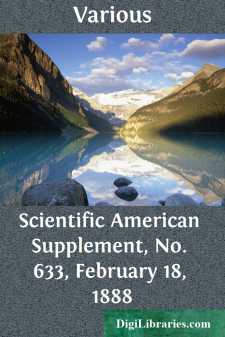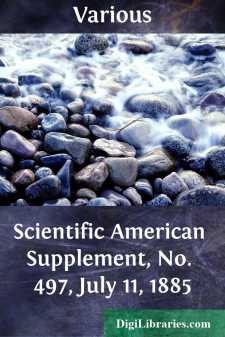Categories
- Antiques & Collectibles 13
- Architecture 36
- Art 48
- Bibles 22
- Biography & Autobiography 813
- Body, Mind & Spirit 142
- Business & Economics 28
- Children's Books 15
- Children's Fiction 12
- Computers 4
- Cooking 94
- Crafts & Hobbies 4
- Drama 346
- Education 46
- Family & Relationships 57
- Fiction 11828
- Games 19
- Gardening 17
- Health & Fitness 34
- History 1377
- House & Home 1
- Humor 147
- Juvenile Fiction 1873
- Juvenile Nonfiction 202
- Language Arts & Disciplines 88
- Law 16
- Literary Collections 686
- Literary Criticism 179
- Mathematics 13
- Medical 41
- Music 40
- Nature 179
- Non-Classifiable 1768
- Performing Arts 7
- Periodicals 1453
- Philosophy 64
- Photography 2
- Poetry 896
- Political Science 203
- Psychology 42
- Reference 154
- Religion 513
- Science 126
- Self-Help 84
- Social Science 81
- Sports & Recreation 34
- Study Aids 3
- Technology & Engineering 59
- Transportation 23
- Travel 463
- True Crime 29
Scientific American Supplement, No. 633, February 18, 1888
by: Various
Categories:
Description:
Excerpt
THE COMPOUND STEAM TURBINE.
Last year the whole of the lighting of the Newcastle Exhibition was effected by the agency of seventeen of these motors, of which four were spare, giving in the aggregate 280 electrical horse power. As the steam was provided by the authorities of the exhibition, it was good proof to the public that they had satisfied themselves that the consumption would not be extravagant as however favorable might be the terms on which the manufacturers would be willing to lend their engines, they could scarcely be sufficiently tempting to compensate for an outrageous consumption of coal, even in Newcastle. At the time we gave an account of the result of the test, showing that the steam used was 65 lb. per electrical horse power, a very satisfactory result, and equal to 43 lb. per indicated horse power if compared with an ordinary engine driving a generator through a belt. Recently Mr. Parsons has given an account of the theory and construction of his motor before the Northeast Coast Institution, and has quoted 52 lb. of steam per electric horse power as the best result hitherto attained with a steam pressure of 90 lb. As now made there are forty-five turbines through which the steam passes in succession, expanding in each, until it is finally exhausted.
THE COMPOUND STEAM TURBINE.The theoretical efficiency of a motor of this kind is arrived at by Mr. Parsons in the following manner:
The efflux of steam flowing from a vessel at 15.6 lb. per square inch absolute pressure through an orifice into another vessel at 15 lb. pressure absolute is 366 ft. per second, the drop of pressure of 0.6 lb. corresponding to a diminution of volume of 4 per cent. in the opposite direction. The whole 45 turbines are so proportioned that each one, starting from the steam inlet, has 4 per cent. more blade area or capacity than that preceding it. Taking the pressure at the exhaust end to be 15 lb. absolute, that at the inlet end will be 69 lb. above the atmosphere. The steam enters from the steam pipe at 69 lb. pressure, and in passing through the first turbine it falls 2.65 lb. in pressure, its velocity due to the fall being 386 ft. per second, and its increase of volume 3.85 per cent. of its original volume. It then passes through the second turbine, losing 2.55 lb. in pressure, and gaining 3.85 per cent. in volume, and so on until it reaches the last turbine, when its pressure is 15.6 lb. before entering, and 15 lb. on leaving. The velocity due to the last drop is 366 ft. per second. The velocity of the wheels at 9,200 revolutions per minute is 150 ft. per second, or 39.9 per cent. of the mean velocity due to the head throughout the turbines. Comparing this velocity with the results of a series of experiments made by Mr. James B. Francis on a Tremont turbine at Lowell, Mass., it appears that there should be an efficiency of 72 per cent. if the blades be equally well shaped in the steam as in the water turbine, and that the clearances be kept small and the steam dry. Further, as each turbine discharges without check into the next, the residual energy after leaving the blades is not lost as it is in the case of the water turbine, but continues into the next guide blades, and is wholly utilized there. This gain should be equal to 3 to 5 per cent.
As each turbine of the set is assumed to give 72.5 per cent. efficiency, the total number may be assumed to give the same result, or, in other words, over 72 per cent. of the power derived from using the steam in a perfect engine, without losses due to condensation, clearances, friction, and such like. A perfect engine working with 90 lb. boiler pressure, and exhausting into the atmosphere, would consume 20.5 lb. of steam per hour for each horse power. A motor giving 70 per cent. efficiency would, therefore, require 29.29 lb. of steam per horse power per hour. The best results hitherto attained have been 52 lb. of steam per hour per electrical horse power, as stated above, but it is anticipated that higher results will be attained shortly. Whether that be so or not, the motor has many advantages to recommend it, and among these is the increased life of the lamps due to the uniform rotation of the dynamo. At the Phœnix Mills, Newcastle, an installation of 159 Edison-Swan lamps has been running, on an average, eleven hours a day for two years past, yet in that time only 94 lamps have failed, the remaining 65 being in good condition after 6,500 hours' service....












